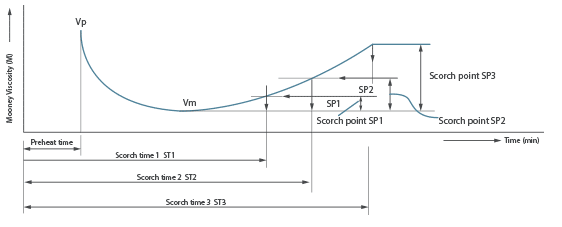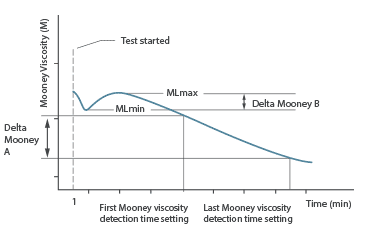SMV-301/301RT - Приложения
Mooney Viscometer

Most of the documents on the LITERATURE is available in PDF format. You will need Adobe Acrobat Reader to open and read PDF documents. If you do not already have Acrobat Reader, you can download it free at the Adobe's Website. Click the GET ADOBE READER icon on the left to download a free copy of Adobe Acrobat Reader.
Rubber Viscoelasticity Evaluation from Mooney Viscosity to Stress Relaxation

Operating Principle and Mooney Viscosity
A drive motor rotates a rotor in the center of a cylindrical test chamber formed from upper and lower dies. The test chamber is filled with the sample and the rotor is rotated with the sample heated to a given constant temperature. The torque on the rotor, applied by sample resistance, is detected by a load cell and measured as the sample's Mooney viscosity.
The rotating force on the rotating plate, generated from the rotor counter torque, applies a thrust force, P, on the load cell. JIS K 6300 specifies using standard weights to calibrate the load cell so that a Mooney viscosity value of 100 is equivalent to a rotor counter torque of 8.30 N-m.

The Mooney viscosity test is performed to measure the Mooney viscosity of raw rubber and rubber compounds. Mooney viscosity is the viscosity reached after the rotor rotates for a given time interval (Mooney time setting). JIS K 6300 specifies measuring the Mooney viscosity four minutes after the preheating time ends. However, SMV-301/301RT models allow the user to specify up to ten Mooney viscosity detection times.



The Mooney scorch test is performed to determine the scorch time of rubber compounds. In the scorch test, viscosity decreases before increasing as vulcanization progresses. The test measures the time (scorch time) it takes for viscosity to increase from a minimum viscosity value (Vm) to a specified increased value (scorch point). JIS standards prescribe a scorch point of 5 M. Model SMV-301 allows the user to specify up to 10 arbitrary scorch points, and measure the peak value (Vp), minimum value (Vm), and scorch times.


Capable of Measuring Differences in Mooney Viscosity
(in accordance with ISO 289-3)

Delta Mooney A:
The difference in Mooney viscosity between the first and last detection time settings specified is determined.
Delta Mooney B:
The difference in Mooney viscosity between the minimum value (MLmin) and the maximum value thereafter (MLmax) is determined.

The system allows stress relaxation measurements in accordance with ISO 289-4 and ASTM D 1646.
If the rotor is suddenly stopped after the Mooney viscosity test, the stress in the sample attenuates. The stress relaxation test determines the attenuation rate of the stress (torque) as a function of time. The relaxation of stress in rubber materials tends to depend on a combination of viscosity and elasticity, where a slower relaxation indicates a higher level of elastic components and a faster relaxation indicates a higher level of viscous components. The Mooney viscosity reflects the molecular weight of unvulcanized rubber, whereas the stress relaxation value is related to the rubber structure, such as the molecular weight distribution, molecular chains, and gel components. Therefore, it can be used to evaluate the mixing and processing characteristics of rubber.


Decay Time

tx (sec):
Assuming a 100 % torque value after the rotor stops, tx is the time it takes for the torque to decrease by X % (user specified value).
Xt (%):
Assuming a 100 % torque value after the rotor stops, Xt is the proportional attenuation of torque at a time t seconds after the rotor stops (user-specified value).


